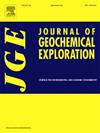套印矿床流体包裹体水序贯热提取新方法
IF 3.3
2区 地球科学
Q1 GEOCHEMISTRY & GEOPHYSICS
引用次数: 0
摘要
流体包裹体(FI)作为地壳流体库存的地质记录的重要性目前已得到广泛认可。然而,较少被接受的是它们在提供流体同位素化学的明确信息方面的可靠性。这种不确定性是完全合理的,因为FI的定量分析提出了几个技术问题。例如,使用少量的水,一般为30 μL,这可能会导致错误。此外,发现只含有一种FI代的地质材料是不寻常的。对多种包裹体的研究提供了对流体活动变化的令人兴奋的见解。多代FI的存在使大样本分析方法复杂化,并导致数据解释偏差。为了避免这些问题,我们创造了一种新的方法来识别多个或特定的热液事件。我们使用了来自世界级金银多事件(墨西哥Sierra Madre Occidental San Dimas District)的数据来描述这种顺序热提取方法,该方法允许:(i)估计多个或特定FI代的老化温度范围,(ii)提取多个或特定FI代的FI水,以及(iii)分析多代捕获水的δ18O和δ2H。结果表明,石英晶体FI水的δ18O和δ2H值具有可重复性,与不同共生事件的地质和地球化学对比结果一致。本文章由计算机程序翻译,如有差异,请以英文原文为准。

New method to sequential thermal extract of fluid inclusion water associated with overprinted mineral deposits
The importance of fluid inclusions (FI) as a geological record of the fluid inventory of the earth's crust is current widely recognized. Less accepted, however, is their reliability in providing unequivocal information on the isotopic chemistry of the fluids. Such uncertainties are fully justified since the quantitative analysis of FI presents several technical issues. For example, the use of a small amount of water, typically <30 μL, which could lead to errors. Also, it is unusual to find geological materials that contain only one FI generation. The study of multiple populations of inclusion offers an exciting insight into changes in fluid activity. The existence of multiple generations of FI complicates bulk sample analysis methods and led to data interpretation bias. To avoid these issues, we created a new method to identify multiple or particular hydrothermal events. We used data from a world-class silver‑gold multi-event (San Dimas District, Sierra Madre Occidental, Mexico) to describe this sequential thermal extraction method, that allows: (i) estimate decrepitation temperature range for multiple or particular FI generation, (ii) extract FI water for multiple or particular FI generations, and (iii) analyze δ18O and δ2H of trapped water from multiple generations. Our findings demonstrate that obtained δ18O and δ2H results of FI water of quartz crystals are reproducible and consistent with geological and geochemical contrasts on the different paragenetic events.
求助全文
通过发布文献求助,成功后即可免费获取论文全文。
去求助
来源期刊

Journal of Geochemical Exploration
地学-地球化学与地球物理
CiteScore
7.40
自引率
7.70%
发文量
148
审稿时长
8.1 months
期刊介绍:
Journal of Geochemical Exploration is mostly dedicated to publication of original studies in exploration and environmental geochemistry and related topics.
Contributions considered of prevalent interest for the journal include researches based on the application of innovative methods to:
define the genesis and the evolution of mineral deposits including transfer of elements in large-scale mineralized areas.
analyze complex systems at the boundaries between bio-geochemistry, metal transport and mineral accumulation.
evaluate effects of historical mining activities on the surface environment.
trace pollutant sources and define their fate and transport models in the near-surface and surface environments involving solid, fluid and aerial matrices.
assess and quantify natural and technogenic radioactivity in the environment.
determine geochemical anomalies and set baseline reference values using compositional data analysis, multivariate statistics and geo-spatial analysis.
assess the impacts of anthropogenic contamination on ecosystems and human health at local and regional scale to prioritize and classify risks through deterministic and stochastic approaches.
Papers dedicated to the presentation of newly developed methods in analytical geochemistry to be applied in the field or in laboratory are also within the topics of interest for the journal.
 求助内容:
求助内容: 应助结果提醒方式:
应助结果提醒方式:


